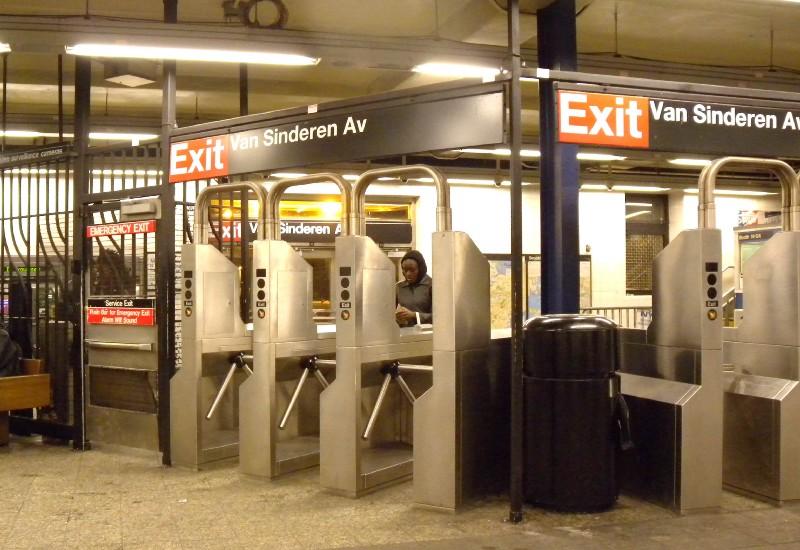This $2.75 gateway to jail targets New York’s poorest black neighborhoods
In New York City, many demographics are eligible for subsidized MetroCards, which allow them to access the increasingly expensive and dysfunctionalsubway system at a lower cost. Transit benefits are available to the elderly, disabled, and schoolchildren, and many companies offer their employees pre-tax MetroCards as part of their benefits package. But one group of New Yorkers is conspicuously left out […]

In New York City, many demographics are eligible for subsidized MetroCards, which allow them to access the increasingly expensive and dysfunctionalsubway system at a lower cost. Transit benefits are available to the elderly, disabled, and schoolchildren, and many companies offer their employees pre-tax MetroCards as part of their benefits package. But one group of New Yorkers is conspicuously left out when it comes to reduced-cost subway and bus access: Those living in poverty.
Low-income New Yorkers who can’t afford the $2.75 cost of a ride are frequently arrested for fare evasion. It’s a punishment that falls hardest on black residents in high poverty neighborhoods. And while the prevalence of racial disparities in transit enforcement isn’t a revelation, a new report from the Community Service Society of New York (CSSNY) maps fare-beating arrests in Brooklyn for the first time, illustrating their high concentration in the city’s poorest neighborhoods.
Further, The Crime of Being Short $2.75 emphasizes that this punishment for poverty falls harder not just on communities of color broadly, but specifically on low-income black New Yorkers. The report shows that fewer farebeating arrests take place near stations in high-poverty predominately Latinx neighborhoods, compared to their black counterparts, indicating that this targeted policing correlates with race in addition to poverty.
Disturbingly, this concentration of arrests is “not driven by poverty or crime or legitimate public safety concerns,” Harold Stolper, co-author of the report and CSSNY senior labor economist, tells In Justice Today. “This is broken windows policing at the turnstile.”
Broken windows policing is based on the theory that targeting low-level, nonviolent “quality of life” offenses such as farebeating can prevent more serious crimes. Since the theory emerged in the early 1980’s and was popularized by the New York Police Department in the 1990’s, however, the tactic has been criticized for its uneven application between communities of color and whites, its ineffectiveness, and its role in further fracturing police and community relations.
CSSNY’s findings further reveal the targeted impact of broken windows policing, which has been decried and challenged by grassroots organizers in New York City for years. By gathering arrest data from both the NYPD and two public defender organizations in Brooklyn and overlaying it with 2016 census data, the organization was able to get a more complete picture of exactly who is being arrested for fare evasion and where.
On Monday, City Councilmember Rory Lancman introduced a bill that would require the NYPD to file quarterly reports of all arrests and summonses issued for fare evasion, including demographic information of those arrested. Lancman tweeted that his bill “fills in gaps in [the] current reporting system.” With only the current NYPD arrest data, CSSNY would not have had a complete picture — hence their inclusion of stats from public defenders’ offices.
The findings illustrate how the city’s justice system criminalizes poverty in black neighborhoods. For example, young black men (ages 16 to 36) represented half of all fare evasion arrests in Brooklyn in 2016, but only comprise 13.1% of poor adults in the borough, according to the report. The highest number of fare evasion arrests per 100,000 MetroCard swipes occurred at subway stations near the border of Brownsville and East New York, two of Brooklyn’s poorest neighborhoods.
Meanwhile, blacks make up less than one-third of Brooklyn adults living in poverty, but two-thirds of those arrested for fare evasion. The report shows that the greatest concentration of fare evasion arrests occur at stations “nearest to the poorest and predominately black census tracts.” Stolper and his coauthor, Jeff Jones, attribute the disparate enforcement to the rise of broken windows policing, high arrest rates driven by quotas from NYPD supervisors, as well as explicit and implicit bias.
On top of the problematic ties between poverty, race, and policing, the report notes that farebeating arrests are expensive, estimating that the city spends roughly $50 million per year to arrest, prosecute, or fine low-income New Yorkers unable to afford the fare. “Why is the city spending all of this money to over-police the turnstile…instead of helping them access transit to get to work and to get to school?” asks Stolper.
In April, a budget proposal from the City Council called for that same amount — $50 million — to fund a pilot program that would subsidize half-price MetroCards for low-income New Yorkers. Mayor Bill de Blasio argued that the cost should fall on the state, not the city, and in June declined to include the program in the budget. CSSNY supports the idea of half-price MetroCards, as well as decriminalizing fare evasion.
But decriminalization comes with its own pitfalls. Issuing summonses instead of arresting those who evade the fare doesn’t address the issue of policing that targets neighborhoods by race and income.
Stolper acknowledges this, saying “decriminalization is not the answer, but we support it,” and adding that ending broken windows policing is the best way to stop the criminalization of poor New Yorkers at the turnstile. The Coalition to End Broken Windows, an alliance of community-based grassroots organizations, agrees that broken windows should be the real target, but argue that decriminalization is not an acceptable solution. While summonses might seem better than a trip to jail, they do come with fines that are unrealistic for people already living in poverty. And unpaid fines can lead to open arrest warrants which, you guessed it, lead right back to jail.
“It’s better than having a criminal record,” says Stolper, “But if you can’t afford $2.75, you can’t afford $100.”
